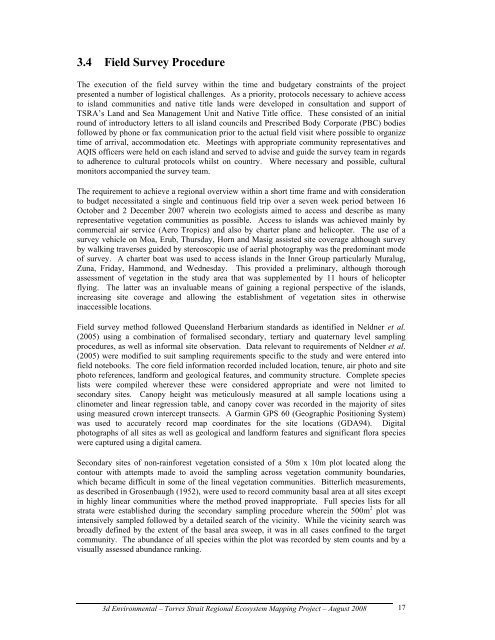Appendix 2 - Vegetation Communities and Regional Ecosystems
Appendix 2 - Vegetation Communities and Regional Ecosystems
Appendix 2 - Vegetation Communities and Regional Ecosystems
You also want an ePaper? Increase the reach of your titles
YUMPU automatically turns print PDFs into web optimized ePapers that Google loves.
3.4 Field Survey Procedure<br />
The execution of the field survey within the time <strong>and</strong> budgetary constraints of the project<br />
presented a number of logistical challenges. As a priority, protocols necessary to achieve access<br />
to isl<strong>and</strong> communities <strong>and</strong> native title l<strong>and</strong>s were developed in consultation <strong>and</strong> support of<br />
TSRA’s L<strong>and</strong> <strong>and</strong> Sea Management Unit <strong>and</strong> Native Title office. These consisted of an initial<br />
round of introductory letters to all isl<strong>and</strong> councils <strong>and</strong> Prescribed Body Corporate (PBC) bodies<br />
followed by phone or fax communication prior to the actual field visit where possible to organize<br />
time of arrival, accommodation etc. Meetings with appropriate community representatives <strong>and</strong><br />
AQIS officers were held on each isl<strong>and</strong> <strong>and</strong> served to advise <strong>and</strong> guide the survey team in regards<br />
to adherence to cultural protocols whilst on country. Where necessary <strong>and</strong> possible, cultural<br />
monitors accompanied the survey team.<br />
The requirement to achieve a regional overview within a short time frame <strong>and</strong> with consideration<br />
to budget necessitated a single <strong>and</strong> continuous field trip over a seven week period between 16<br />
October <strong>and</strong> 2 December 2007 wherein two ecologists aimed to access <strong>and</strong> describe as many<br />
representative vegetation communities as possible. Access to isl<strong>and</strong>s was achieved mainly by<br />
commercial air service (Aero Tropics) <strong>and</strong> also by charter plane <strong>and</strong> helicopter. The use of a<br />
survey vehicle on Moa, Erub, Thursday, Horn <strong>and</strong> Masig assisted site coverage although survey<br />
by walking traverses guided by stereoscopic use of aerial photography was the predominant mode<br />
of survey. A charter boat was used to access isl<strong>and</strong>s in the Inner Group particularly Muralug,<br />
Zuna, Friday, Hammond, <strong>and</strong> Wednesday. This provided a preliminary, although thorough<br />
assessment of vegetation in the study area that was supplemented by 11 hours of helicopter<br />
flying. The latter was an invaluable means of gaining a regional perspective of the isl<strong>and</strong>s,<br />
increasing site coverage <strong>and</strong> allowing the establishment of vegetation sites in otherwise<br />
inaccessible locations.<br />
Field survey method followed Queensl<strong>and</strong> Herbarium st<strong>and</strong>ards as identified in Neldner et al.<br />
(2005) using a combination of formalised secondary, tertiary <strong>and</strong> quaternary level sampling<br />
procedures, as well as informal site observation. Data relevant to requirements of Neldner et al.<br />
(2005) were modified to suit sampling requirements specific to the study <strong>and</strong> were entered into<br />
field notebooks. The core field information recorded included location, tenure, air photo <strong>and</strong> site<br />
photo references, l<strong>and</strong>form <strong>and</strong> geological features, <strong>and</strong> community structure. Complete species<br />
lists were compiled wherever these were considered appropriate <strong>and</strong> were not limited to<br />
secondary sites. Canopy height was meticulously measured at all sample locations using a<br />
clinometer <strong>and</strong> linear regression table, <strong>and</strong> canopy cover was recorded in the majority of sites<br />
using measured crown intercept transects. A Garmin GPS 60 (Geographic Positioning System)<br />
was used to accurately record map coordinates for the site locations (GDA94). Digital<br />
photographs of all sites as well as geological <strong>and</strong> l<strong>and</strong>form features <strong>and</strong> significant flora species<br />
were captured using a digital camera.<br />
Secondary sites of non-rainforest vegetation consisted of a 50m x 10m plot located along the<br />
contour with attempts made to avoid the sampling across vegetation community boundaries,<br />
which became difficult in some of the lineal vegetation communities. Bitterlich measurements,<br />
as described in Grosenbaugh (1952), were used to record community basal area at all sites except<br />
in highly linear communities where the method proved inappropriate. Full species lists for all<br />
strata were established during the secondary sampling procedure wherein the 500m 2 plot was<br />
intensively sampled followed by a detailed search of the vicinity. While the vicinity search was<br />
broadly defined by the extent of the basal area sweep, it was in all cases confined to the target<br />
community. The abundance of all species within the plot was recorded by stem counts <strong>and</strong> by a<br />
visually assessed abundance ranking.<br />
3d Environmental – Torres Strait <strong>Regional</strong> Ecosystem Mapping Project – August 2008<br />
17


